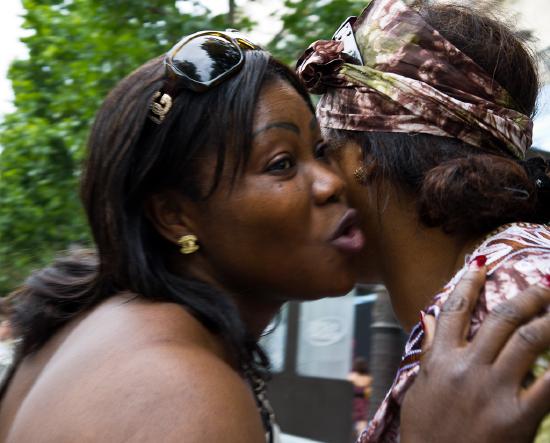1.9: Francophonie - Points Culturels
- Page ID
- 157787
In this section, you will learn about:
- French greeting customs
- Francophone countries and regions
Listen to the audio clips that follow on this page to hear the French pronunciation of vocabulary and examples presented.
On découvre !

"FR Society 35: French Kiss" by francisco_osorio is licensed under CC BY 2.0
Points Culturels
Greetings in French
Cultural practices differ in French-speaking countries regarding greetings. In France, it is common to say 'Bonjour' and 'Au revoir' when entering small shops, independently owned medical practices and offices to greet employees, customers or patients. At work, such greetings are common with professional acquaintances we often see but don't really start a conversation with.
With people we know a bit better such as colleagues, neighbors, friends, or family members, it is customary to add a gesture such as the kisses on the cheeks 'la bise' or a handshake. 'Se faire la bise' is a cultural gesture that has a few rules to observe: the number of kisses (2, 3, 4) and the side to start (right or left) will depend on each region.
As a French custom, one has to remember that it is not a true kiss on the cheek but more of an 'air' kiss where the cheeks touch while each person makes a smacking sound. This custom is practiced across gender, age, and social groups. When in doubt, follow your peers, or the other person's lead, and keep in mind that it is safer for professional acquaintances to use handshakes as there are more untold norms to respect such as rank and the 'culture' of each business.
Tu vs Vous
Addressing someone in French-speaking countries can be challenging as it entails using Tu (informal you) for interactions between family, friends, peers or Vous (formal you) in everyday life with professional colleagues, acquaintances and service employees. To be safe consider using the formal Vous when meeting new people and follow your French interlocutor's lead who will invite you to use Tu to break the ice if appropriate.
With each new interaction, gaging the inherent social norms between Tu or Vous will become easier.
Un regard, un sourire ?
In everyday life while in public spaces, walking in the streets or taking public transportation (bus, metro, tramway), it is noteworthy to mention that French people avoid eye contact with strangers, do not smile nor say 'Bonjour' to people they do not intend to start a conversation with. For Americans, it is a common gesture. This French cultural difference reflects how strangers respect others' personal space even in crowded locations. Choosing to make eye contact is a sign that a person wants to start a conversation to ask for help or information which is totally acceptable to do too.
La Francophonie
Explore the Francophone world.
- Select "Commencer l'exercice 1" to start the practice exercises (not-graded)
- Need extra help? Check out the English version of the video.
La Francophonie des Amériques
Explore the Francophone presence in the Americas with Francophonie des Amériques.
On approfondit ! (Practice only-not graded)
Use the following resources to type accents and/or search for words:
- Accents: ç, à, é, è, â, ê, î, ô, û, ù, ë, ï, ü
- Dictionnaire français-anglais


